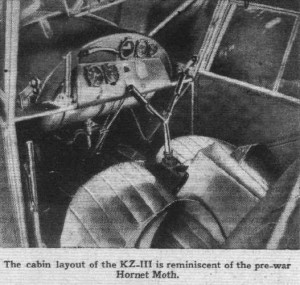 The British magazine Flight wrote in their July 25th 1946 issue.
The British magazine Flight wrote in their July 25th 1946 issue.
Some time ago – in the issue of November 1st last year – we gave some details of a new Danish-built cabin two-seater light aircraft known as the KZ-III. A fortnight ago one of these interesting little aircraft paid a short visit to this country before being flown on to the Deauville Rally, and, later, to other Continental airfields. While here and at Deauville, a number of British pilots had the chance of flying it and were enthusiastic about its characteristics.
The most noticeable of these is, thanks to the full-span fixed slots and slotted flaps, a quite unusual gentle stall at an indicated flying speed very much lower than the 34 m.p.h. given as the “landing speed”. Although the reading probably subject to considerable position error, it does suggest that the aircraft does everything claimed by the manufacturer. At its lowest speed the machine merely sinks on a level keep. Since, on the power of a Cirrus Minor II, the maximum speed is 115 m.p.h. and the cruising speed is 106 m.p.h., the KZ-III should be very useful utility type.
The most noticeable of these is, thanks to the full-span fixed slots and slotted flaps, a quite unusual gentle stall at an indicated flying speed very much lower than the 34 m.p.h. given as the “landing speed”.
In a very general way it resembles the pre-war Puss and Leopard Moths in that it is a strut-braced high-wing aircraft, and it follows more up-to-date ideas in the layout of a wide side-by-side-seater cabin. This layout, in fact, provides cause for one minor criticism – the the view to the rear is almost non-existent. Later this year, however, a four-seater version is to be put into production, and this will have a transparent root and rear windows, which will right the matter.
Structurally the KZ-III is conventional with two-spar fabric and ply-covered wooden main-plain, and fabric-covered steel-fuselage.





 29/12/2009
29/12/2009
Leave a reply